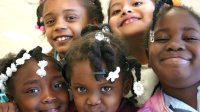Six Tips for Teaching Social and Emotional Skills After School
WINGS for Kids best practices: 14 years of know-how building after-school success.
Courtesy of WINGS for Kids
WINGS for Kids began 14 years ago as an all-girl summer camp. Since then, we've morphed, expanded, shrunk, made mistakes, learned, and finally grown into a coed, nonprofit after-school program that serves 500 kids in and around Charleston, South Carolina, and we have plans to expand across the country. Our methods have improved, yet our mission has always remained the same: to teach children the social and emotional skills they need to navigate challenges and succeed in school, work, and life -- all in 15 hours a week for children in grades K-5.
Here are some winning strategies we've learned along the way. We hope they help you and the children in your classroom or community, too.
1. Educate all staff members, including administrators, on the basics and benefits of SEL.
The success of a program hinges greatly upon the staff. If the staff does not buy into social and emotional learning (SEL), the teaching will never make it to the children. The Collaborative for Social and Emotional Learning (CASEL) and Edutopia's social and emotional learning page are great places to get this info.
Using the Language of the Creed: WINGS instructor Raymond Harris seizes an opportunity to reinforce the creed before teaching play formations in basketball class.
2. Train all staff on SEL-supported behavior-management techniques.
Creating a supportive, trusting environment is critical. Staff should catch negative behavior before it escalates but also should avoid using punishment. One of the strategies WINGS uses is GET PAST ( 74K), a set of techniques for dealing with misbehavior in a positive way. We have had great success in helping kids overcome behavior obstacles that are getting in the way of all the children having a positive experience.
3. Create policies that encourage specific, positive feedback.
If you're focusing on teaching SEL skills, it is important for kids to know you're watching! Children crave attention and are more likely to display positive behaviors if we take the time to recognize their efforts. The positive feedback you give should be as specific as possible. For example, saying, "Thank you for cleaning up all the crayons without being asked" is more effective than simply saying, "Good job."
Our Kids Praise Awards ( 77K) program helps guide this process. We ask every staff member to give at least five pieces of meaningful feedback to kids each day. (To help us remember, we use a little game called Five Cents' Worth of Positive Feedback. 57K) You can find more instructions in our guidelines for giving effective feedback ( 44K).
This strategy applies to families too. For example, every family member who walks in the door at WINGS must hear at least one piece of positive feedback about his or her child.
4. Reserve at least 30 minutes for community building each day.
Community building is an excellent way to promote relationship-skill building. A recent brief published by the nonpartisan research center Child Trends ( 180K) said that the most important practice for out-of-school programs is "positive and sustained relationships with caring adults." At WINGS, we start the day building community with Community Unity, a half-hour gathering during which children and staff members greet each other, go over the week's theme, share news, play games, and have fun. Small groups of children stay with the same staff member for Community Unity all year, so they build strong relationships together.
5. Incorporate intentional SEL lessons.
We teach social and emotional skills through both explicit and implicit lessons. Our explicit lessons revolve around the WINGS Creed -- a daily chant that reminds kids how they can control their emotions in everyday situations -- and weekly teaching objectives ( 107K), such as identifying your feelings or resisting peer pressure. Throughout the WINGS day, instructors are expected to look for teachable moments where they can employ the creed and the objectives in conversation with students.
Implicit lessons are woven into all of our activities in order to reinforce these teachings. In an arts and crafts session, for instance, children might make T-shirts bearing a message about peer pressure. Stimulating and challenging activities offer plenty of opportunities for children to get overexcited or frustrated, and these are opportunities for us to teach the children appropriate ways of calming themselves down. We use a variety of fun Hot Wings activities to teach these skills. Our activities during circle time ( 334K) are also an important means of emphasizing social and emotional lessons without explicitly saying so.
6. Link your program with what's happening in school.
We work with each of the schools WINGS serves to keep lines of communication open among school faculty and WINGS staff all year long. We achieve this by using the following techniques:
WINGS leader sit-ins: Each WINGS leader works closely with a group, or "nest," of 10 to 12 children all year long. In September and January, WINGS leaders visit during school hours to see their kids in the classroom. They watch for behavior problems displayed by their kids, and they're encouraged to talk with the teachers and inform them of issues at WINGS with particular children. Sometimes we find that a child's classroom behavior differs greatly from his or her WINGS behavior, and it's helpful to speak with that child later to discuss these differences.
Daily academic focus: In order to direct attention to school achievement, we tie our weekly lessons to the district's academic standards. Each Monday, we select an academic standard (that alternates between math and reading) and weave it throughout the curriculum that week. WINGS leaders receive a list of ideas of how to teach this standard daily. They're encouraged to use these ideas and develop their own creative ways to tie the standard to their activities with the kids.
